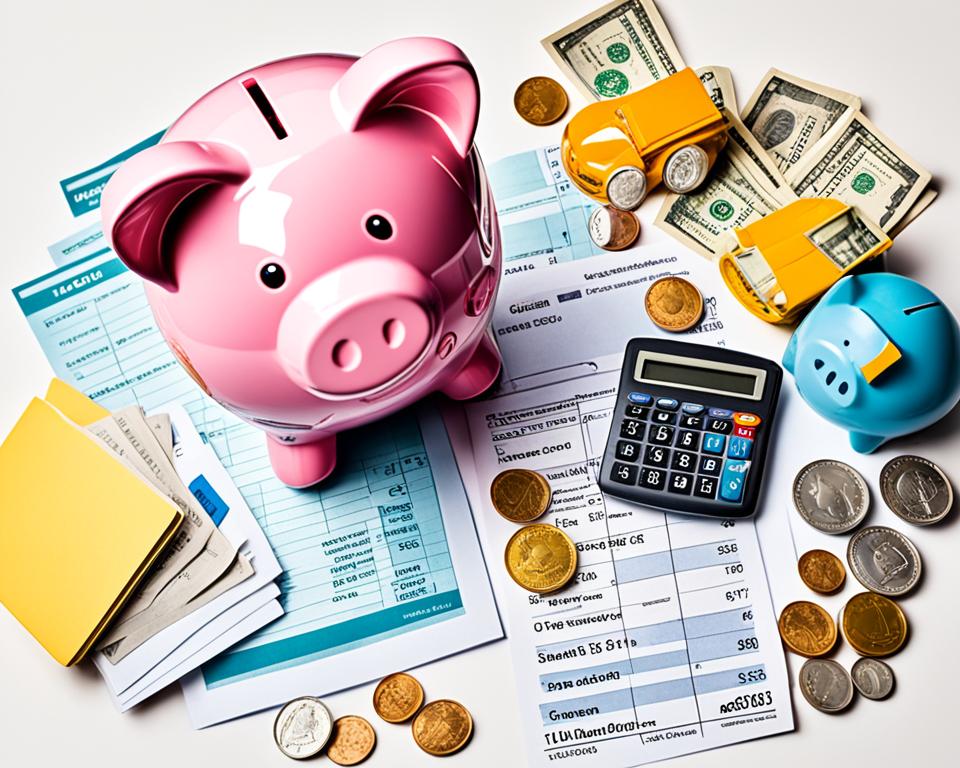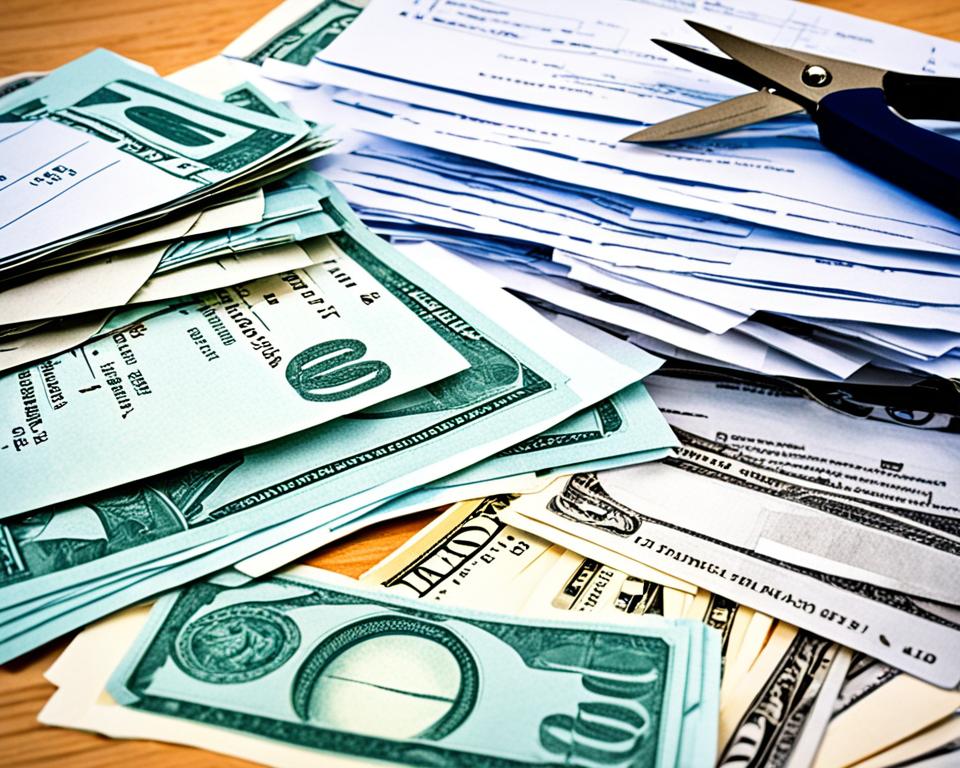When it comes to managing your finances, finding ways to save money and make smart decisions is essential. One option that can help you achieve this is loan refinancing.
Loan refinancing is the process of paying off an existing loan and replacing it with a new one. This can be a beneficial move if you want to lower your interest rate, change your loan term, consolidate debt, or fund home renovations. By refinancing, you have the opportunity to improve your financial situation and potentially save a significant amount of money in the long run.
Before diving into the world of loan refinancing, it’s important to understand the ins and outs of this financial strategy and when it makes the most sense for you. In this article, I will explain the basics of loan refinancing and provide insights into when you should consider it.
Key Takeaways:
- Loan refinancing is the process of replacing an existing loan with a new one.
- Refinancing can help you lower your interest rate, change your loan term, consolidate debt, or fund home renovations.
- Consider factors such as current mortgage rates, after-tax monthly savings, and the cost of obtaining a new mortgage when deciding if refinancing is right for you.
- Refinancing may not be a wise decision if you plan to move soon, are already halfway through your loan term, or have other financial goals that should take priority.
- Calculate the break-even point to determine if the potential savings of refinancing outweigh the closing costs.
When Should You Refinance Your Loan?
When considering loan refinancing, it’s important to assess various factors to determine if it’s the right financial move for you. Here are some key considerations:
Current Mortgage Rates
Keep an eye on the current mortgage rates. Refinancing is generally more favorable when interest rates are low or stable. If rates have dropped significantly since you obtained your loan, it may be a good time to explore refinancing options.
After-Tax Monthly Savings
Calculate your potential after-tax monthly savings by refinancing. Look at how much you could save on your monthly payments and evaluate if the savings are substantial enough to make a difference in your financial situation.
Loan Term and Homeownership Duration
Consider how long you intend to stay in your current home. If you plan to move soon, the cost of refinancing may outweigh the potential benefits. Similarly, if you’re already halfway through your loan term, the savings from refinancing may not justify the associated costs.
Cost of Obtaining the New Mortgage
Take into account the cost of obtaining the new mortgage. Refinancing typically involves closing costs, such as origination fees, appraisal fees, and title insurance. Make sure to compare these costs with the potential savings to determine if refinancing makes financial sense for you.
By carefully considering these factors, you can make an informed decision about whether to refinance your loan. Remember to calculate your return on investment and evaluate if refinancing aligns with your long-term financial goals.
Reasons to Refinance Your Loan
Refinancing your loan can offer several benefits that can help you improve your financial situation. Whether you want to save money on monthly payments, pay off your loan faster, consolidate high-interest debt, eliminate PMI, or fund home renovations, refinancing can provide a solution. By understanding the potential advantages and considering your specific needs, you can make an informed decision about whether to refinance your loan.
Saving Money on Monthly Payments
One of the primary reasons to refinance your loan is to save money on your monthly payments. By securing a lower interest rate or extending the loan term, you can reduce the amount you need to pay each month. This increased cash flow can provide you with more financial flexibility and allow you to allocate funds towards other priorities.
Paying Off Your Loan Faster
If your financial circumstances have improved since you first obtained your loan, refinancing can be an opportunity to pay off your loan faster. By opting for a shorter loan term or making higher monthly payments, you can accelerate your path to debt-free homeownership and save money on interest payments over time.
Consolidating High-Interest Debt
If you have multiple sources of high-interest debt, such as credit cards or personal loans, refinancing your loan can enable you to consolidate these debts into one manageable payment. By combining your debts into a new mortgage with a lower interest rate, you can save money, simplify your finances, and potentially lower your overall monthly payments.
Eliminating PMI
If you currently have private mortgage insurance (PMI) on your loan, refinancing can be an opportunity to eliminate this additional cost. If your home’s value has increased and you now have at least 20% equity, refinancing can allow you to remove the requirement for PMI and reduce your monthly mortgage payments.
Tapping into Home Equity for Cash or Home Renovations
Refinancing can also provide you with a way to tap into your home equity for cash or fund home renovations. Through a cash-out refinance, you can borrow against the equity in your home and use the funds for various purposes. Whether you need to cover unexpected expenses, invest in home improvements, or finance other important projects, refinancing can serve as a source of available capital.
Calculating the Benefits
Before deciding to refinance your loan, it’s essential to understand the potential benefits and assess whether they align with your financial goals. Consider factors such as the current interest rates, the amount of time it will take to recoup the closing costs, and your long-term plans for homeownership. By carefully evaluating these aspects, you can determine whether refinancing is the right choice for you.
| Benefits of Refinancing | Considerations |
|---|---|
| Saving money on monthly payments | Lower interest rates, extended loan terms |
| Paying off your loan faster | Shorter loan terms, higher monthly payments |
| Consolidating high-interest debt | Lower interest rates, simplified finances |
| Eliminating PMI | Increased home equity, potential cost savings |
| Tapping into home equity | Funding for cash needs or home renovations |
Refinancing your loan can offer numerous advantages, such as the ability to save money, achieve financial goals, and improve your overall financial well-being. However, it’s essential to carefully evaluate your specific circumstances and consider the costs and benefits before making a decision. If you’re unsure, consult with a trusted mortgage professional who can provide guidance tailored to your needs.
Lower Your Interest Rate
Are you looking to save money on your mortgage? Refinancing your loan can provide you with a lower interest rate, helping you reduce your monthly payments and potentially save thousands of dollars over the life of your loan.
If interest rates have dropped since you first obtained your loan, refinancing can be a great option to take advantage of lower rates. By refinancing at a lower interest rate, you can lower your monthly payment and keep more money in your pocket.
Additionally, if your credit score has improved since you first received your loan, you may be eligible for better mortgage rates. Lenders offer the best rates to borrowers with excellent credit, so it’s important to check your credit report and understand your risk profile.
Reducing your interest rate not only saves you money every month, but it can also significantly decrease the total amount of interest you pay over the life of your loan. Even a small decrease in your interest rate can result in substantial savings in the long run.
When considering refinancing, it’s essential to calculate your potential savings and determine if the cost of refinancing is worth it. Closing costs and fees associated with refinancing should be taken into account when weighing the benefits. A reputable mortgage professional can help you analyze the numbers and make an informed decision.
“By refinancing my loan and securing a lower interest rate, I was able to save over $200 per month. It’s made a significant difference in my monthly budget and long-term financial goals.”
Don’t miss the opportunity to lower your interest rate and potentially save thousands of dollars. Consult with a trusted mortgage lender to explore the best mortgage rates available to you and discover how refinancing can improve your financial situation.
Consolidate High-Interest Debt
A cash-out refinance can be an effective strategy for consolidating high-interest debt and taking control of your finances. By tapping into your home’s equity, you can use the funds to pay off credit card balances or other forms of debt that are draining your financial resources. Consolidating your debt through a cash-out refinance offers several benefits, including:
- Saving money on interest payments
- Streamlining your debt into a single, manageable monthly payment
- Reducing overall financial stress
By consolidating your debt with a cash-out refinance, you can take advantage of potentially lower interest rates and simplify your financial obligations. This approach allows you to focus on a single monthly payment while working towards achieving your financial goals.
Whether you’re burdened with high-interest credit card debt or other financial obligations, a cash-out refinance can provide the opportunity to consolidate and take control of your debt. By leveraging the equity in your home, you can save money and simplify your financial life, giving you peace of mind and a clearer path towards financial freedom.
Eliminate PMI
If you’re a homeowner, you may be familiar with private mortgage insurance (PMI). Many lenders require PMI if your down payment is less than 20 percent of the home’s value. However, if your home’s value has increased since you purchased it, you may have enough equity to eliminate PMI through refinancing.
By refinancing your loan and reaching the 20 percent equity threshold, you can remove the additional cost of PMI from your monthly payments. This can result in significant savings over time and allow you to allocate those funds towards other financial goals or enjoy a larger disposable income.
To determine if you’re eligible to eliminate PMI through refinancing, you’ll need to consider your home’s current value and calculate your equity position. If you believe you’ve reached or surpassed the 20 percent equity threshold, it’s worth exploring refinancing options with your lender or speaking to a mortgage professional for guidance.
Refinancing to eliminate PMI can provide you with both short-term and long-term financial benefits. Not only will you reduce your monthly expenses by removing the cost of PMI, but you’ll also have the opportunity to potentially secure a lower interest rate or adjust other terms of your mortgage to better fit your financial goals.
Did You Know? Eliminating PMI through refinancing is a smart move for borrowers who have built equity in their homes. It’s a strategic way to reduce unnecessary expenses and maximize your homeownership experience.
If you’re considering refinancing to eliminate PMI, it’s essential to carefully evaluate your financial situation, including your long-term homeownership goals, before making a decision. Refinancing typically involves closing costs, so you’ll want to ensure that the anticipated savings from removing PMI outweigh these expenses over the course of your loan term.
Remember, every homeowner’s situation is unique, and it’s important to thoroughly assess the costs and benefits specific to your circumstances. Consulting with a trusted mortgage professional can provide you with personalized guidance and help you make an informed decision regarding PMI elimination through refinancing.
Change Your Loan Term
If you’re looking to adjust your loan repayment schedule, refinancing offers the flexibility to change the term of your loan. Whether you need a shorter or longer loan term, refinancing can help you achieve your financial goals.
Shorter Loan Term:
If you’re eager to pay off your mortgage sooner and save on interest expenses, refinancing to a shorter loan term can be a smart move. By opting for a shorter loan term, you’ll likely face a slightly higher monthly payment. However, this decision will enable you to build equity faster and ultimately pay off your loan in a shorter period of time. With a shorter loan term, you’ll be on your way to financial freedom and home ownership. Remember, it’s crucial to assess your current financial situation and ensure that the higher monthly payments fit comfortably within your budget.
Longer Loan Term:
If you find it challenging to meet your monthly mortgage payments due to financial constraints or other obligations, refinancing to a longer loan term can provide relief. By extending the term of your loan, you can reduce your monthly payments, making them more affordable and manageable. This provides you with the breathing room you need to navigate your financial responsibilities without sacrificing homeownership. It’s important to consider the trade-off between lower monthly payments and the increased overall interest you may pay throughout the extended loan term.
To determine whether a shorter or longer loan term is the right choice for you, evaluate your current financial situation, your long-term goals, and your overall budget. Consulting with a trusted mortgage professional can provide valuable insights and guide you in making an informed decision.
Remember, refinancing is a financial strategy that should align with your unique circumstances and objectives. By tailoring your loan term to your specific needs, you can optimize your mortgage payments and create a more secure financial future.

“Refinancing my loan allowed me to adjust the term and fit my budget better. With a shorter loan term, I save on interest and will own my home sooner. It’s a win-win!” – Jane Doe
Pay for Home Renovations
If you’re planning home renovations that will increase your property value, a cash-out refinance can be a smart way to fund those projects. By tapping into your home’s equity and using the funds from a cash-out refinance, you can make the improvements you desire and potentially increase the resale value of your home in the future.
When you do a cash-out refinance, you essentially take out a new mortgage for more than you owe on your current loan, and you receive the difference in cash. This extra money can be used to finance various home renovation projects, such as remodeling your kitchen, adding an additional bathroom, or upgrading your outdoor living space.
One of the major advantages of using a cash-out refinance for renovations is that you can leverage the equity you’ve built in your home. Home equity is the difference between the market value of your property and the amount you owe on your mortgage. By using your home equity, you can access a larger pool of funds compared to other types of loans, such as personal loans or credit cards.
Additionally, a cash-out refinance allows you to take advantage of potentially lower interest rates compared to other types of loans. Since mortgage rates are often lower than interest rates for personal loans or credit cards, refinancing can save you money in interest payments over the life of the loan.
Before proceeding with a cash-out refinance for renovations, it’s important to consider the following factors:
- The estimated cost of your home renovations
- The current equity in your home
- The total amount you’re eligible to borrow
- Your ability to repay the refinanced loan
By evaluating these factors, you can ensure that a cash-out refinance is the right financial decision for your home renovation needs. Keep in mind that taking on additional debt through a refinance should be done with careful consideration and a solid plan for repaying the loan.
When Not to Refinance
While there are many situations where refinancing your loan can be advantageous, there are also times when it may not be the best financial decision for you. It’s essential to consider these factors before deciding to refinance. Here are some circumstances when you may want to avoid refinancing:
- Planning to Move Soon: If you’re planning to sell your home in the near future, refinancing may not make sense. The costs associated with refinancing, such as closing costs, may outweigh the potential benefits if you won’t have enough time to recoup those costs.
- Already Halfway Through Your Loan Term: If you’re already halfway through the term of your current loan, refinancing may reset the clock and extend the repayment period. This can result in paying more interest over time, making refinancing less advantageous.
- Other Financial Goals Taking Priority: If you have other pressing financial goals, such as paying off high-interest debt or saving for a down payment on a new home, it may be wise to prioritize those goals before considering refinancing.
- Recent Home Purchase: If you’ve recently bought your home, it may not be the ideal time to refinance. Lenders typically recommend waiting at least six months to a year before considering a refinance, as this allows you to establish good payment history and build equity in your home.
It’s important to weigh the potential benefits of refinancing against the costs involved, such as closing costs and potential interest rate hikes. Evaluating your specific financial situation and consulting with a trusted mortgage professional can help you make an informed decision.
How Much Does It Cost to Refinance?
Refinancing your mortgage comes with closing costs that you’ll need to be prepared for. The cost of refinancing varies depending on factors such as the location of your property, the company servicing your loan, and the specific fees that apply to your situation.
It’s important to consider these costs and factor them into your decision-making process. While refinancing can offer financial benefits in the long run, you’ll need to weigh these potential savings against the upfront expenses.
One option you have is to roll the closing costs into your new loan. This means that instead of paying the closing costs out-of-pocket, they are added to the principal balance of your loan. While this allows you to finance the closing costs and avoid upfront payment, it’s essential to keep in mind that by doing so, the total amount that accrues interest over time will increase.
Understanding the cost of refinancing is crucial in planning and budgeting for this financial move. Be sure to gather quotes from different lenders and carefully review the closing costs associated with each offer. Also, consider consulting with a reliable mortgage professional to get a clear understanding of all the fees involved and how they will affect your overall refinancing expenses.
How Much Can You Save by Refinancing?
The potential savings from refinancing your loan can vary depending on several factors, including the closing costs associated with the new loan. It’s important to calculate the refinance break-even point to determine when the amount you save will exceed the costs you incurred.
I recommend using a refinance break-even calculator to help you determine how long it will take for the savings from refinancing to offset the closing costs you paid. The longer you stay in your home after refinancing, the more you can save in the long run.
By refinancing at the right time and under favorable circumstances, you can potentially save a significant amount of money. However, it’s essential to carefully analyze the costs and benefits of refinancing before making a decision.
| Factors to Consider | Potential Savings |
|---|---|
| Interest Rate Reduction | Lower monthly mortgage payments |
| Consolidation of High-Interest Debt | Savings from paying off high-interest loans or credit card debt |
| Elimination of PMI | Savings from removing private mortgage insurance |
| Change in Loan Term | Long-term interest savings or improved cash flow |
| Funding for Home Renovations | Potential increase in property value and future return on investment |
Understanding the potential savings from refinancing and the refinance break-even point will help you make an informed decision about whether to proceed with refinancing your loan. Consult with a trusted mortgage professional who can guide you through the process and provide personalized advice based on your financial situation and goals.
Conclusion
In conclusion, understanding loan refinancing is essential for optimizing your financial situation. Refinancing can help you save money, reduce monthly payments, and achieve your long-term goals. However, it’s crucial to carefully evaluate the benefits and costs of refinancing, taking into account factors such as interest rates, loan terms, and closing costs.
Before deciding to refinance, it’s prudent to consult with a trusted mortgage professional who can provide guidance tailored to your specific needs. They can explain the loan refinancing process in detail, ensuring that you make an informed decision that aligns with your financial objectives.
Remember, loan refinancing is a powerful tool, but it’s not suitable for everyone. It’s essential to assess your individual circumstances and determine if the potential savings outweigh the associated costs. By doing your due diligence and seeking expert advice, you can navigate the loan refinancing journey with confidence and secure a brighter financial future.
FAQ
What is loan refinancing?
Loan refinancing is the process of paying off an existing loan and replacing it with a new one.
When should I consider loan refinancing?
You should consider loan refinancing when you want to lower your interest rate, change your loan term, consolidate debt, eliminate PMI, or fund home renovations.
When should you refinance your loan?
The decision to refinance your loan depends on factors such as current mortgage rates, after-tax monthly savings, how long you intend to stay in your home, and the cost of obtaining the new mortgage.
What are the benefits of loan refinancing?
Some benefits of loan refinancing include saving money on monthly payments, paying off your loan faster, consolidating high-interest debt, eliminating PMI, tapping into home equity for cash, and funding home renovations.
How can I lower my interest rate through loan refinancing?
You can lower your interest rate through loan refinancing if rates have dropped since you obtained your loan or if your credit score has improved. It’s important to check your credit report and understand your risk profile.
Can I consolidate high-interest debt through loan refinancing?
Yes, you can consolidate high-interest debt through a cash-out refinance. This allows you to tap into your home’s equity and use the funds to pay off other debts, making managing your finances easier with a single monthly payment.
How can I eliminate PMI through loan refinancing?
If your home’s value has increased, you may be able to refinance to get out of paying private mortgage insurance (PMI). Most commercial home loan products require PMI until you reach 20 percent equity in your property.
Can I change the term of my loan through loan refinancing?
Yes, through loan refinancing, you can change the term of your loan. If you’re struggling to make monthly payments, you can refinance to get a longer loan term for a smaller monthly payment. Alternatively, if you want to pay off your loan faster, you can refinance to get a shorter loan term.
Can I use loan refinancing to pay for home renovations?
Yes, a cash-out refinance can be a smart way to fund your home renovations. By tapping into your home’s equity, you can use the funds from a cash-out refinance to make the improvements you desire and potentially increase the resale value of your home.
When should I avoid loan refinancing?
You should avoid loan refinancing if you plan to move soon, are already halfway through your loan term, have other financial goals that should take priority, or recently purchased your home.
How much does it cost to refinance?
The cost of refinancing your loan depends on factors such as your property’s location, the company servicing your loan, and specific fees that apply to your situation. You can roll the closing costs into your new loan, but this will increase the total amount that accrues interest over time.
How much can I save by refinancing?
The amount you can save by refinancing depends on factors such as closing costs. It’s important to calculate the break-even point, which is when the amount you save exceeds the amount you spent on closing costs. The longer you stay in your home after refinancing, the more you can save.
What is the loan refinancing process?
The loan refinancing process involves assessing your financial goals, checking mortgage rates, calculating potential savings, gathering required documents, applying for a new loan, undergoing a home appraisal, and closing on the new loan.
How do I refinance my loan?
To refinance your loan, you should assess your financial goals, research loan options, collect the necessary documents, apply for a new loan, complete the application process, undergo an appraisal, review and sign the loan documents, and close on the new loan.





